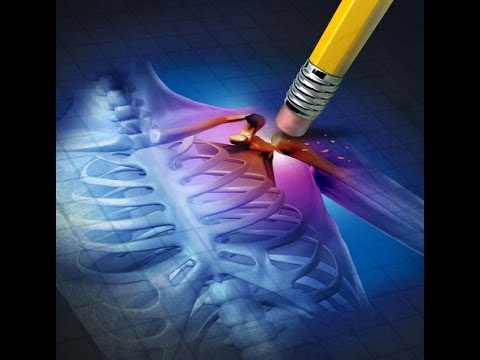
Shoulder Pain? NEVER Sleep In These 3 Positions. Do THIS Instead! Bob and Brad discuss three positions you should never sleep in if you have shoulder pain.

Shoulder Pain? NEVER Sleep In These 3 Positions. Do THIS Instead! Bob and Brad discuss three positions you should never sleep in if you have shoulder pain.

In this video, Doctor Andrea Furlan explains that there is a relationship between what we eat and pain. Chronic inflammation may lead to chronic pain, and there are nutrients in our Western diet that predispose to more inflammation. People with autoimmune diseases are prone to more inflammation because their immune system is attacking their own cells using inflammation. We don’t know if fibromyalgia is an autoimmune disease or not, but people with fibromyalgia have more inflammatory markers than people without fibromyalgia. Changing their diet has a great impact on chronic inflammation. Doctor Furlan explains strategies to change eating habits and how to incorporate an anti-inflammatory diet:

Chronic pain can be caused by many things, and sometimes it’s hard to get any relief. Here are some great ways to help reduce the pain

Clinicians need to be more honest with patients about what they can really expect
It’s a myth that most persistent musculoskeletal pain with no obvious cause can be cured, argue experts in an editorial published online in the British Journal of Sports Medicine.
Doctors and other healthcare professionals need to be a lot more honest with patients about what they can really expect, write Professor Jeremy Lewis, of the University of Hertfordshire and Central London Community Healthcare NHS Trust, and Professor Peter O’Sullivan, of Curtin University, Perth, and Bodylogic Physiotherapy, Perth, Australia.
There’s no magic fix and patients may have to live with their pain as they would any other long term condition, they say.
The fact that most persistent musculoskeletal pain that isn’t the result of injury or trauma has no obvious cause has prompted the development of two unfortunate trends, the authors suggest.
Firstly, structural changes that are commonly seen on the x-rays and scans of people with no pain, such as rotator cuff (muscles over the upper arm bone) tears and intervertebral (spinal) disc degeneration, are often used to explain the pain.
This may not only prompt avoidance behaviours, but also a desire for corrective treatment, leading to unnecessary surgery on tendons, cartilage and bones that aren’t the cause of the pain.
Secondly, some clinicians have arguably invented ‘treatments’ for conditions that may not actually exist or be readily detected, and for which there is no good evidence that they work.
“These two trends have created an expectation that interventions (frequently ‘passive’) will provide a ‘cure,’ and typically quickly, with minimal self-contribution,” write the authors.
But the reality is that many musculoskeletal pain conditions are associated with disability and won’t respond to current (passive) treatment. And they should be managed in the same way that other long term conditions, such as diabetes, are–with a focus not on providing a cure, but on minimising the impact on an individual’s wellbeing, they suggest.
This includes lifestyle changes, such as stopping smoking and stress management, to enable that person to take control of their condition, rather than expecting the clinician to do this with various treatments.
“We need to reframe what is currently doable and achievable in the management of many non-traumatic musculoskeletal presentations, and honest and open conversations regarding the outcome evidence for these disorders needs to be sensitively communicated,” they argue.
“For patients, creating an understanding and expectation that, as with other chronic health conditions, there is no magic cure for persistent and disabling musculoskeletal pain conditions…is the key…By doing this, we can…be more honest with the level and type of care we can and should currently offer, and the outcomes that may be achieved.”

Past studies have explored the therapeutic effect of music, particularly compositions by Mozart, for patients with epilepsy. Researchers at University of Utah Health found pairing music with one of four pain medications offered a promising complementary strategy to treat pain. In particular, the ibuprofen-music pair improved analgesic outcomes in an inflammation pain mouse model by more than 90 percent, while the cannabidiol-music and galanin analog NAX 5055-music pairings significantly reduced inflammation by 70 percent. The results of the study are available online on March 27 in the journal Frontiers in Neurology.
“We know these drugs work without music but they can produce toxicity and adverse effects” said Grzegorz Bulaj, Ph.D., associate professor in Medicinal Chemistry at U of U Health and senior author on the paper. “The holy grail is to combine the right drug with this new paradigm of music exposure, so we do not need as much drug for analgesic effects.”
The researchers evaluated this new strategy using two pain models–one model mimics inflammatory pain (carrageenan model) and one mimics surgical pain (plantar incision). Mice in the study were separated into two groups (five to eight mice per group). The control group was exposed to ambient noise while the music-intervention group listened to three three-hour segments of Mozart for 21 days.
“Music is like DNA. We had musicians analyze sequences of several Mozart pieces to optimize the playlist,” Bulaj said. “This was exciting but challenging to integrate these musical analyses into neuropharmacology.”
The compositions were selected and organized to enhance rhythmic, phrasal and chord progressions.
The study was conducted four times to explore pairing music with ibuprofen (25 mg/kg), cannabidiol (100 mg/kg), levetiracetam (400 mg/kg) and the galanin analog NAX 5055 (4 mg/kg). Both the control and music groups received one suboptimal dose of each drug to evaluate the analgesic effect of music in the pain models.
When paired with music, ibuprofen reduced pain responses in the inflammation pain model by 93 percent, as compared to the drug alone. In addition, music and cannabidiol or NAX 5055 reduced swelling by 21 and 9 percent, respectively in the inflammatory pain model. Music alone also reduced pain by 77 percent in the surgical pain model.
“There is emerging evidence that music interventions can alleviate pain when administered either alone or in combination with other therapies,” said Cameron Metcalf, Ph.D., research assistant professor in Pharmacology and Toxicology at U of U Health and first author on the paper. “I was particularly excited to see reduced swelling in the inflammatory pain model.”
According to Metcalf, medications currently available to treat inflammation do not show such a robust response on such a short timescale.
“It is exciting to think of what this might mean for the anti-inflammatory effects of music interventions and where the research may take us next,” Metcalf said.
The study also explored pairing music with various epilepsy drugs, but the experimental design was inadequate to evaluate the complexity in drug dosing and administration to evaluate this therapeutic strategy.
The study was limited to two pain models and did not explore pain caused by nerve injury (neuropathic pain). In addition, the music intervention in the study was limited to pieces by Mozart. Mice hear at different frequencies than humans, and the effect of music volume or duration remains unclear. It also remains unclear if these results will be duplicated in people. Bulaj believes future studies should explore dose-dependent response of the music-drug pairing.
“If we could package music and other nonpharmacological therapies into mobile apps and deliver them with drugs and it works, it will be better than drugs alone,” Bulaj said. “It is exciting to find new ways to improve pain treatments.”